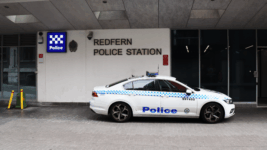‘Skye’s Law’: The Offence of Police Pursuit in New South Wales

New South Wales police officers commenced pursuit of a stolen sedan driven by a teenager accompanied by two friends, down the Camden Valley Way, which lies across Dharawal and Gundungurra land in Sydney’s southwestern fringe, after the driver failed to obey a pull over direction from officers, with he and his pursuers then heading in the direction of Camden’s CBD on Saturday, 15 November 2025.
The pursuing police officers abandoned the chase after the stolen car hit several other vehicles, mounted the footpath and then veered onto the wrong side of the road. The stolen sedan eventually hit a tree near William Avenue, and the teens got out and fled. The young trio then reappeared on Lerida Avenue at 12.10 pm and assaulted a 26-year-old man, before taking off in his BMW.
NSW police were alerted to the theft of the BMW, and on spotting it, officers initiated a second pursuit of this new vehicle through the suburb of Elderslie, continuing in the direction of the Camden CBD. But this pursuit was again abandoned due to erratic driving.
Fire and Rescue NSW was then deployed to Camden’s Onslow Park, where the BMW had been set alight and abandoned.
NSW police subsequently tracked down the teenagers – two boys 16 years old and a 13-year-old girl – not far from the scene of the burning BMW. The arrestees were then taken to Narellan police station and charged with multiple criminal offences. All three were denied bail and were set to appear in the Children’s Court of NSW on Sunday, 16 November.
Police pursuit
The 16-year-old was charged with two counts of police pursuit, contrary section 51B of the Crimes Act 1900 (NSW). To establish these crimes, the prosecution will need to prove the boy was driving whilst being pursued by police, and that he ought reasonably to have been aware of this and that he was required to stop, but he did not, and rather drove recklessly, at speed or in a dangerous manner.
The penalties faced by adults on being charged with police pursuit depend on whether it’s a first ‘major traffic offence’ within 5 years, and if it is, they face 3 years prison and an automatic 3 year licence suspension that the court can reduce to 12 months, otherwise if it is a second or subsequent such offence, 5 years gaol time and 5 years suspension apply, while suspension can drop to 2 years.
The major traffic offences that are involved in this 5-year sentencing regime are listed in section 4 of the Road Transport Act 2013 (NSW). But as the defendant is a juvenile, or aged between 10 to 17, the penalisation regime that applies to them is different to that of adults. And this penalty regime is set out below.
Legal defences against police pursuit
In addition to having to prove each element of the offence of police pursuit beyond a reasonable doubt, the prosecution must disprove to that same high standard any legal defence that may be available on the evidence in the case.
These defences include necessity, duress, self-defence and mental illness.
Necessity is where a person acted to avoid serious, irreversible consequences on themselves or another they were bound to protect, the person honestly and reasonably believed they were in peril if they did not engage in the conduct and the actions were reasonable and proportionate to the situation. This defence may be raised in circumstances of an emergency, such as rushing a seriously injured person to hospital.
Duress is where a person acted due to a threat made to themselves or a loved-one, the threat was serious enough to justify the conduct, it was acting on the person’s mind at the time and was continuing. This defence may be raised where a person was threatened with serious, imminent harm if they did not continue driving; for example, if a weapon was wielded towards them by a passenger in the car and they were told they would be harmed if they stopped for police.
Self-defence is where a person believed their conduct was necessary to defend themselves or another person, or to prevent unlawful deprivation of liberty, or to protect their property from being taken, destroyed, damaged or interfered with, or to prevent criminal trespass to their land, or remove a person criminally trespassing, and the conduct was a reasonable response to the circumstances as the person perceived them. This defence could potentially arise if a person genuinely believed on reasonable grounds that the pursuers intended to cause serious harm to them, and the manner and duration of driving was a reasonable response to the perceived circumstances.
And the defence of mental illness is where a person had a mental health impairment and/or a cognitive impairment that had the effect that they did not know the nature and quality of the act, or did not know that the act was wrong. This could conceivably arise in circumstances of a severe mental health episode while driving.
‘Skye’s law’
The offence of police pursuit is also known as Skye’s law, as it was enacted in response to and named after Skye Sassine, who was killed at just 19 months old, when William Ngati crashed into the back of her parents’ car on New Year’s Eve, 2009. Ngati hit the Sassines’ vehicle whilst fleeing police.
Ever since this incident, the resulting public outcry and the subsequent enactment of Skye’s Law, this offence has been treated in a more serious manner by law enforcement and the courts.
The NSW child sentencing regime
Individuals under 18 years old who are charged with a criminal offence in NSW are then tried in the NSW Children’s Court. This is unless a child is charged solely with a traffic offence, and then it can be dealt with in the NSW Local Court. However, police pursuit is not considered a ‘traffic offence’ under the child sentencing regime.
Penalties applying to youths being tried in the Children’s Court are set out in section 33 of the Children (Criminal Proceedings) Act 1987. If the court finds a child guilty of an offence, it can dismiss the charge or place the child on a good behaviour bond for up to 2 years. The court can also consider imposing a fine of up to $1,100 or otherwise, it can send a child to youth detention for up to 2 years.
Section 210 of the Criminal Procedure Act 2013 (NSW) provides that the section 33 Children (Criminal Proceedings) Act sentencing regime applies to minors tried over traffic offences in the Local Court, and it also details the offences this arrangement applies to.
Further charges accrued
The 16-year-old driver of the stolen car was further charged with several other criminal offences, which again will be penalised in the same manner as the police pursuit charges, via the section 33 sentencing regime.
The first additional count the teen is facing is one of robbery in company, contrary to section 97 of the Crimes Act 1900. “In company” means the defendant is alleged to have committed the crime with at least one other person. If the offender is an adult, this crime can see them put away for up to 20 years.
The boy also has one count of drug possession against him. This crime sits under section 10 of the Drugs Misuse and Trafficking Act 1985 (DMT). The maximum penalties applying to this crime in relation to adult offenders is 2 years prison time and/or a fine of $2,200.
Personal drug possession means a suspect was holding no more than a ‘small quantity’ of a particular illicit substance. Schedule 1 of the DMT lists the different amounts that constitute a ‘small quantity’ of each illegal drug or substance listed.
The last charges the boy is facing are four counts of failing to give particulars to the other driver involved in a crash, which is one of the rules a driver in NSW must comply with if they have been involved in a crash, as per regulation 287 of the Road Rules 2017 (NSW). A driver who breaks any of the listed regulation 287 rules, which include stopping vehicle after accident, faces a fine of $2,200.
Recent police pursuit figures
The NSW Police Force Annual Report 2024-25 outlines that over the 12 months ending in June 2025, 5,029 police pursuits had taken place in NSW. The police terminated 2,727 of these pursuits, while 468 ended in a collision. There were three fatalities related to police pursuits over the 12 month period, along with 36 injuries that occurred in relation to a car chase.
The number of NSW police pursuits have been consistently rising over the last ten years. The number of incidents that occurred over 2015-16 was 2,195, compared with the last financial year’s 5,029 chases, which marks a 129 percent increase over the past decade.








